An article is a piece of writing that provides information, presents ideas, or discusses a topic in a structured manner. You’ll find articles in newspapers, magazines, blogs, websites, and other publications.
In fact, you’re reading one right now.
In this step-by-step guide, we’ll focus on how to write an article for content marketing purposes. And we’ll provide tips on creating high-ranking articles that engage readers.
Let’s dive in.
How to Write an Article in 10 Steps
Content marketing is a significant area of marketing, including video creation, email newsletters, social media posts, blog posts, and more.
Content marketing focuses on providing value to the reader with high-quality content that solves pain points and answers questions without being overly promotional.
Carefully crafted articles and blog posts can help build trust with your existing and potential customers.
They can also help you rank higher in search engines so your target audience can find you, generating more leads and conversions.
Ready to get started?
Follow these 10 article-writing steps to create high-quality content for your audience.
1. Identify Your Target Audience’s Pain Points
The golden rule of content marketing is to write for your audience, not just for search engines.
Writing for your audience means creating content that meets their needs, interests, and challenges. Relevant and valuable articles keep readers engaged and, hopefully, coming back for more.
One of the best ways to speak to your readers is to find out what they need help with. In other words, identify your target audience’s pain points, challenges, and needs.
In fact, our State of Content Marketing: 2023 Global Report found that audience research is the most critical factor for content marketing success.

When you know your audience’s pain points, you can tailor your content to address their needs directly.
How do you identify your audience’s pain points?
Ask them.
Conduct surveys, run focus groups, and hold interviews to collect qualitative data. Listen to how they use your product, what led them to use it, and what it helps them achieve.
You can also conduct audience research through forums, social media groups, and online communities where your target audience spends time. Pay attention to the questions they ask and the problems they discuss. This real-time interaction can reveal common pain points.
It’s a good idea to document your findings in a buyer persona template. You can organize insights, paint a comprehensive picture of your potential customer, and share it across teams.
Semrush offers a free buyer persona tool to help you build buyer personas for your business. The tool includes several customizable templates and provides questions to guide you through the process.
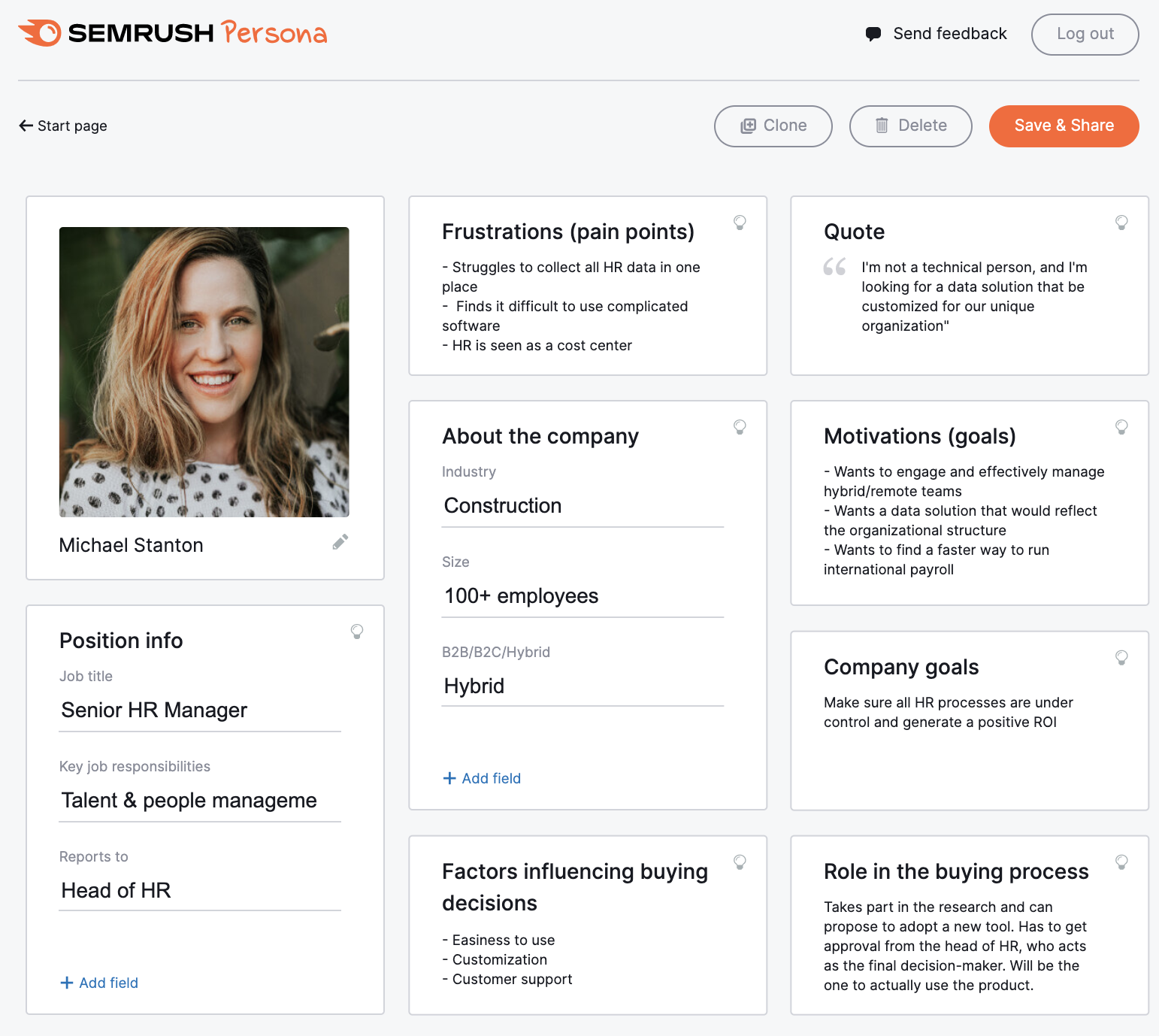
The tool also helps you reflect on what matters to your target audience—like what motivates their buying decisions, what frustrates them, and how they prefer to find answers to their questions.
To gather more information on your target audience to use in the Semrush Persona tool, check relevant forums.
How?
Let’s say you sell a B2B sales tool. Checking forums such as Quora and Reddit gives you insights into the questions, concerns, and discussions around this topic.
For instance, here are some questions people have asked on Quora related to B2B sales, including “How does one close B2B sales lead opportunities?” and “Can B2B sales ever be 100% automated?”:
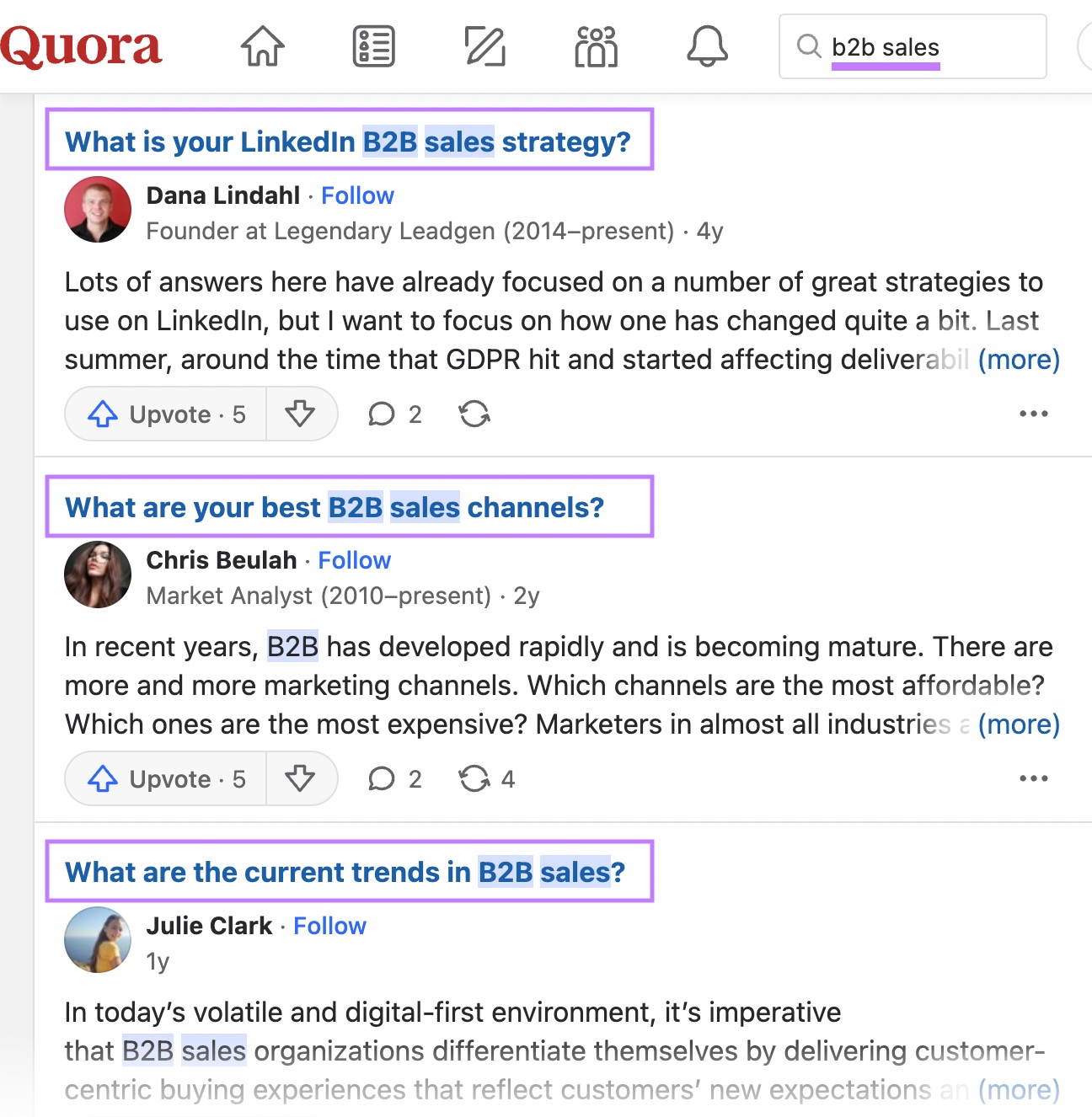
You can use these questions in several ways:
- Identify pain points, motivations, and factors that influence buying decisions to create accurate buyer personas
- Brainstorm topic ideas for content
- Write articles that meet your target audience’s specific needs and interests
For example, sales CRM software company Close answered a common B2B question in their article below:
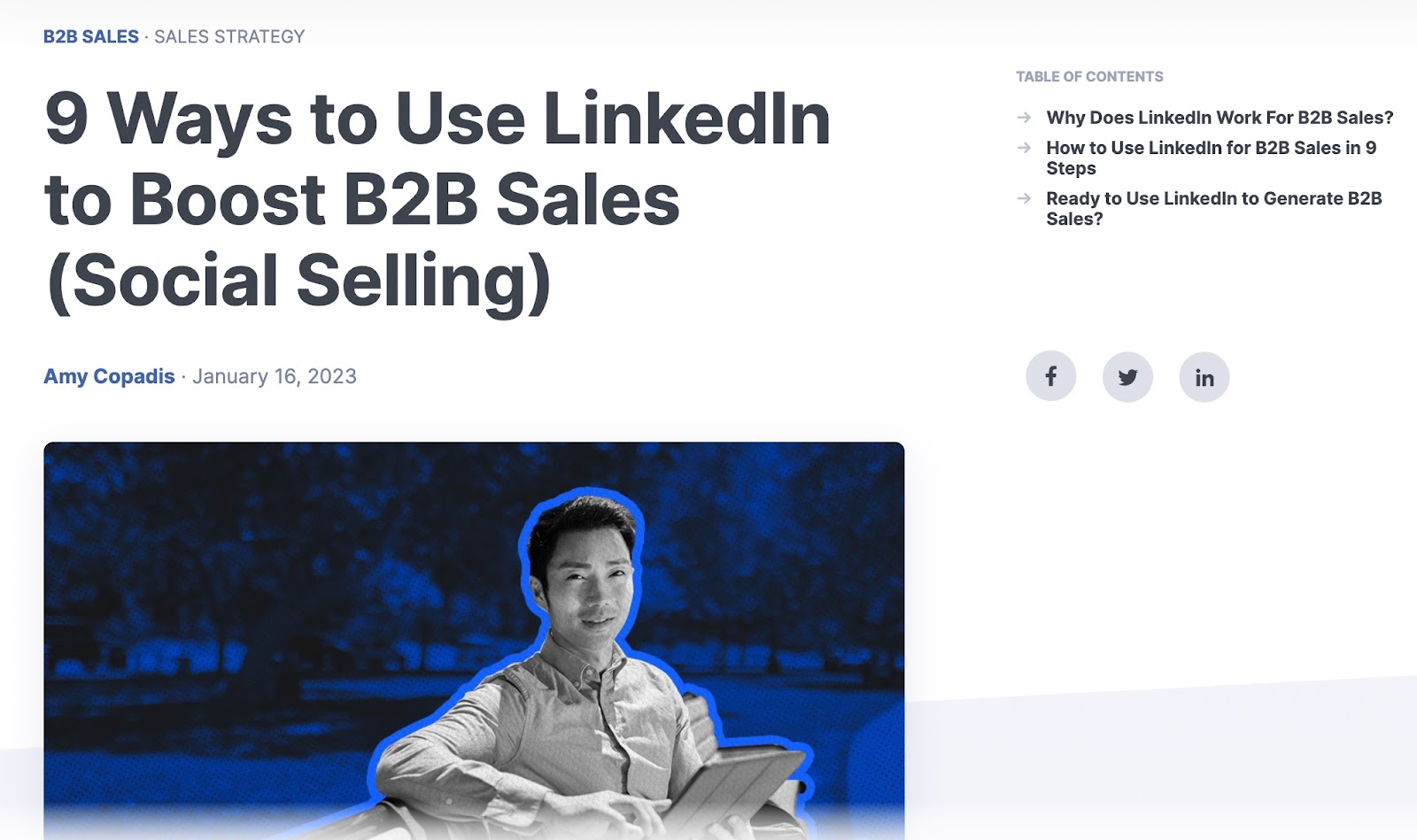
Not only did Close directly address this question with comprehensive, educational content, but it also helped establish the brand as an authority in the B2B sales space.
2. Determine Your Target Keywords
Combining audience needs with the right keywords will help your target audience find your content.
Keywords are words or phrases users type into search engines to get information or explore products. For example, “best smartphones,” “how to bake a chocolate cake,” and “digital marketing tips.”
Adding a relevant target keyword to your article tells search engines your article contains information about this query.
If it meets other standards, like being engaging enough to keep readers on the page, it increases your chances of search engines showing your article the next time someone searches for that keyword or a variation of it.
In the past, marketers tried to trick search engines by adding excessive keywords to content, hoping it would make their pages appear higher in search results.
This strategy created poor-quality content that frustrated users.
Not anymore.
Today, Google is smarter. It identifies (and penalizes) this practice.
To evaluate the quality of content, Google considers how long people stay on a webpage and whether they click on links. If your content keeps people engaged, it signals to search engines that your content is valuable, and they may rank your website higher as a result.
Further reading: SEO Ranking: Factors, Tips, & Tools to Improve Your Positions
Now, how do you find the right keywords?
Use a keyword research tool like the Keyword Magic Tool to find keywords and phrases relevant to your topic and niche.
Navigate to Semrush and open the Keyword Magic Tool. Next, enter the seed (or broad) keyword and hit “Search”:
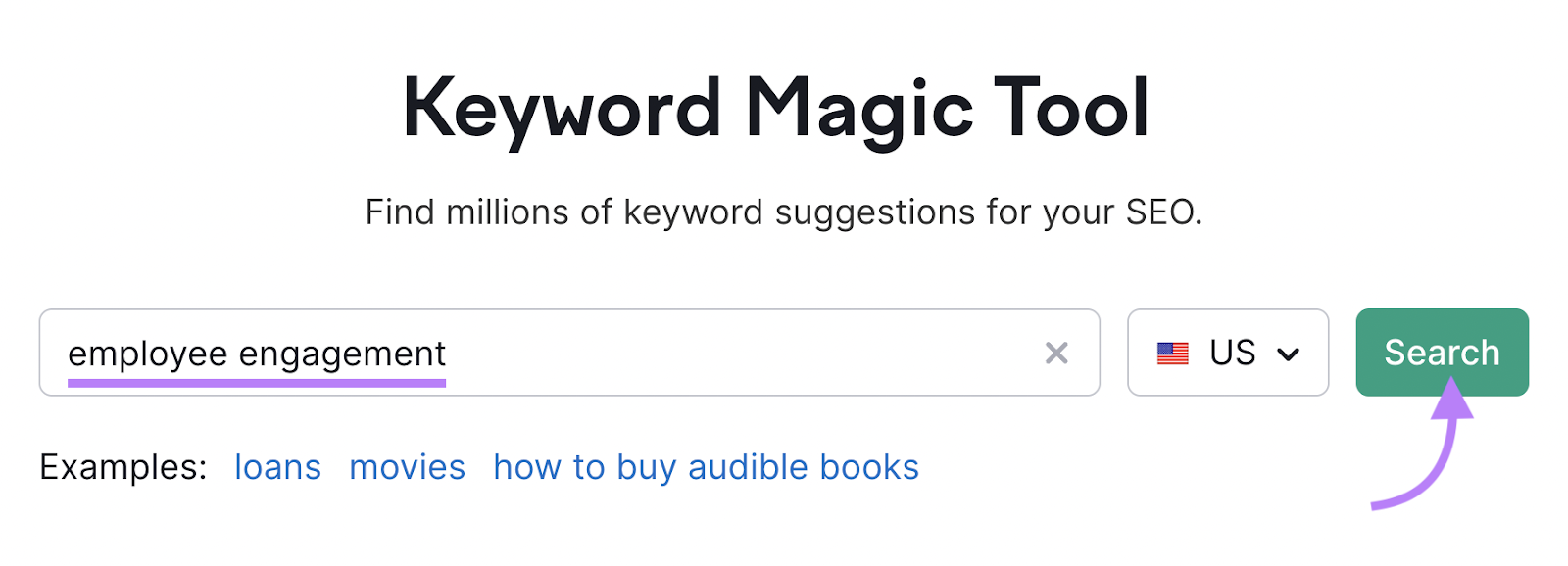
The tool will present a range of keywords, phrases, and questions based on the keyword you entered:
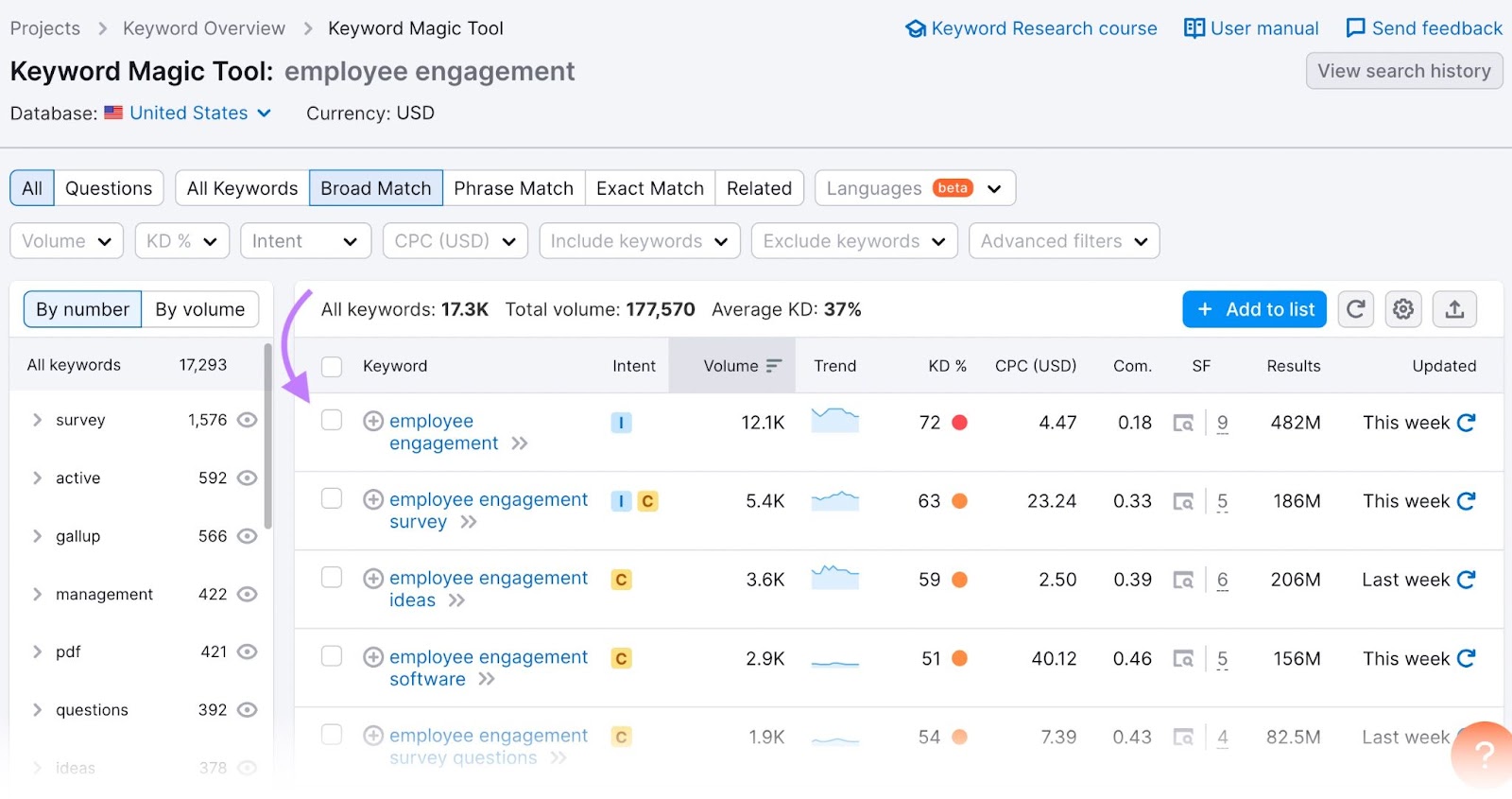
In the example above, the Keyword Magic Tool returned over 17,000 keywords.
Narrow it down by considering two key metrics:
- Search volume: How popular is the keyword? The higher the monthly search volume (measured over a 12-month period), the higher your potential traffic could be if your article ranks well.
- Keyword difficulty (KD): How difficult is it to rank for your chosen keyword? The greater the keyword difficulty, the harder it is to rank for the keyword.
Both of these metrics can be found in the Keyword Magic tool:
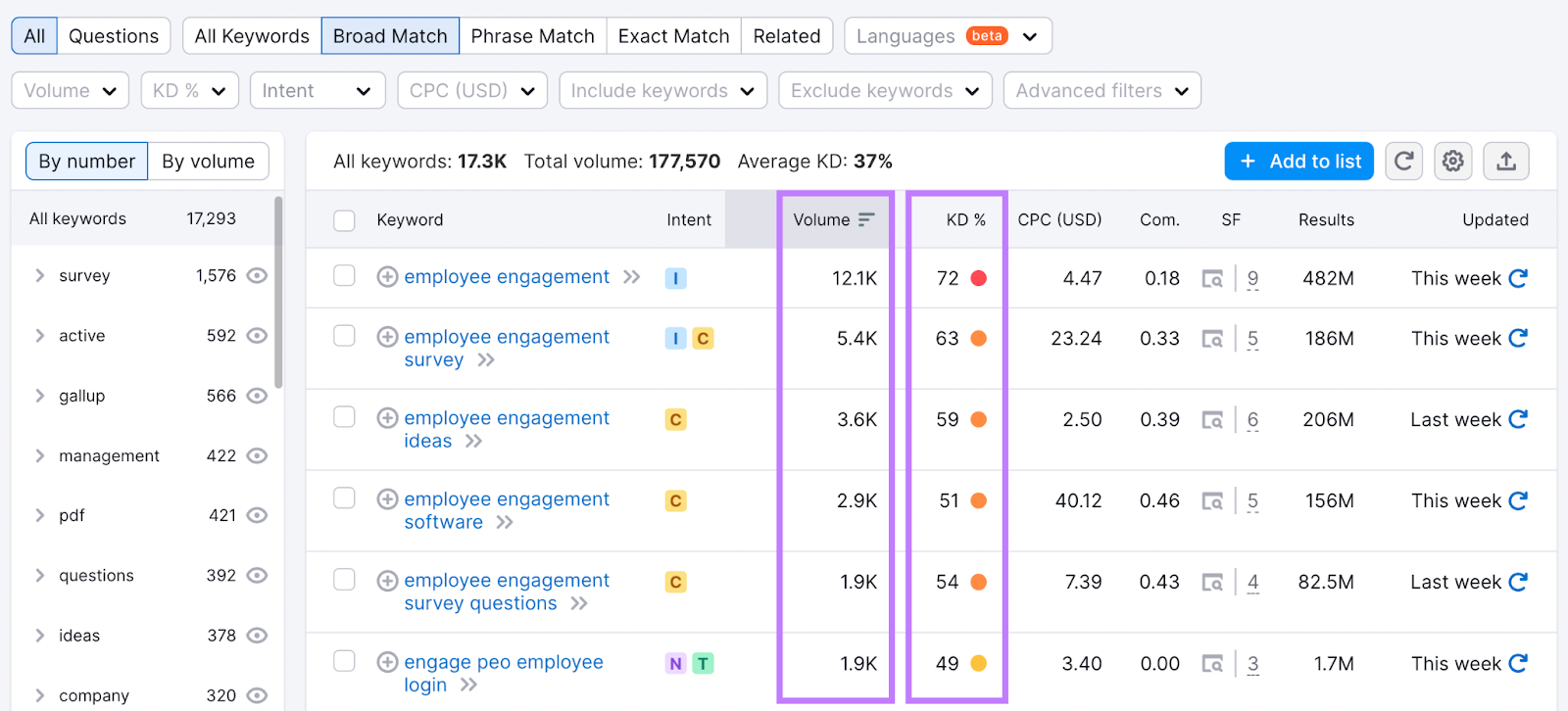
You can also target long-tail keywords, which are specific search queries with relatively low search volumes. These queries are often made up of several words like “what is employee engagement?”
In fact, a Backlinko study showed that keywords containing 10 to 15 words get almost twice as many clicks (1.76 times) than single-word terms.
What makes long-tail keywords better?
- They tend to be less competitive than short-tail keywords. This makes them easier to rank for in search engines.
- As they’re more specific, people searching for these keywords generally have a clearer idea of what they’re looking for and are closer to taking action. This can result in higher-quality traffic, leading to more conversions.
Here’s a long-tail keyword example: Longer keywords usually have fewer searches—and it’s easier to rank for them. (Hover over the color-coded circle in the Keyword Magic Tool for an explanation of the difficulty score.)

Once you’ve researched keywords and matched them to your audience research, save the relevant terms in a keyword list.
To do this, select the chosen keywords and click “Add to keyword list.” Give your list a name and continue to save terms as you do more research.
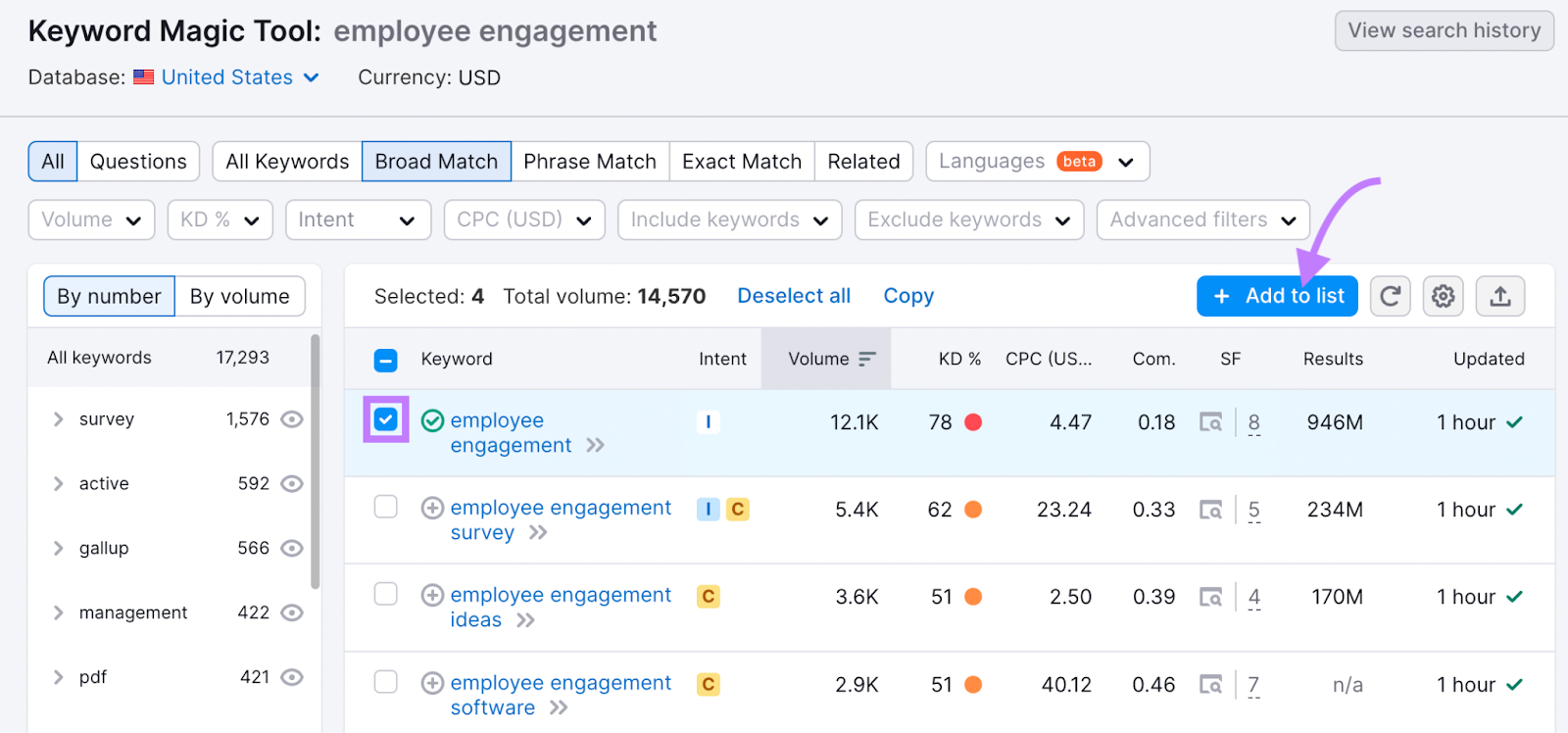
This way, you’ll have your keyword research all in one place, so you can have them handy when creating content.
3. Conduct Topic Research
A critical part of learning how to write an article is topic research.
Why?
Google and readers value well-researched articles.
Google’s Search Quality Rater Guidelines consider E-E-A-T (Experience, Expertise, Authoritativeness, and Trustworthiness) when evaluating the quality of a page.
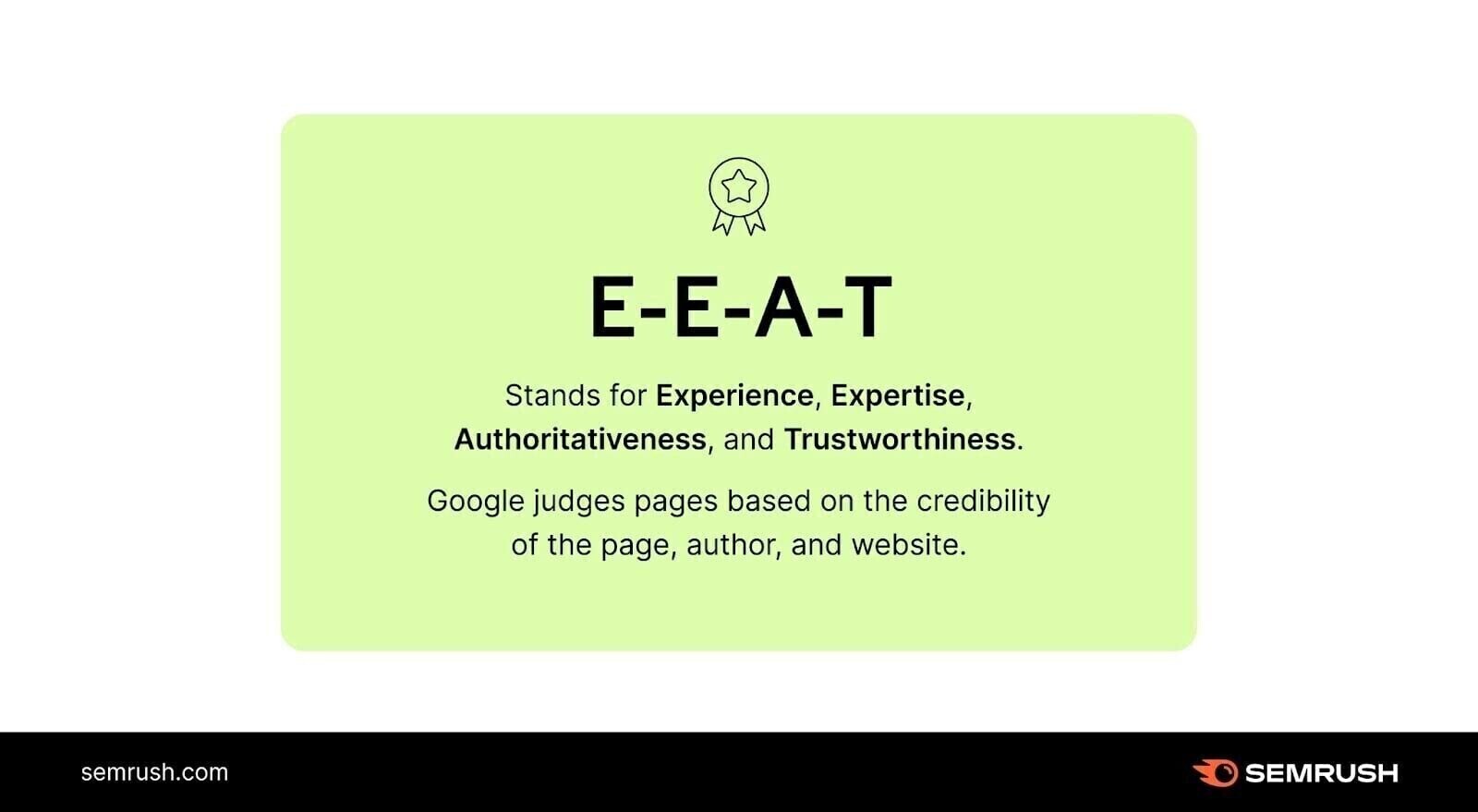
This is where research comes into play.
Thorough research on your topic helps you dig deeper, uncover valuable insights, and provide your audience with accurate and reliable information.
Here are some ways to build expertise and authority in your articles:
- Choose reliable sources: Select authoritative and reputable sources for your research. This could include academic journals, industry publications, or government reports.
- Dive deep: Get into the finer details of your topic. Explore different angles and viewpoints. The more comprehensive your understanding, the more valuable your article will be.
- Fact-check: Verify the accuracy of the information you gather. Cross-reference data from multiple sources to ensure its reliability. Avoid using unverified or outdated information.
- Attribute properly: Give credit to the sources you use in your article. Proper attribution adds credibility and transparency.
- Include quotes and interviews: Conduct interviews with subject matter experts to gain unique insights and firsthand knowledge.
Here’s an example of a well-researched article by Backlinko called Understanding & Demonstrating Google E-E-A-T: A Complete Guide.
The article includes links to research reports and studies from reputable sources. The information is backed by data, enhancing its reliability and trust.
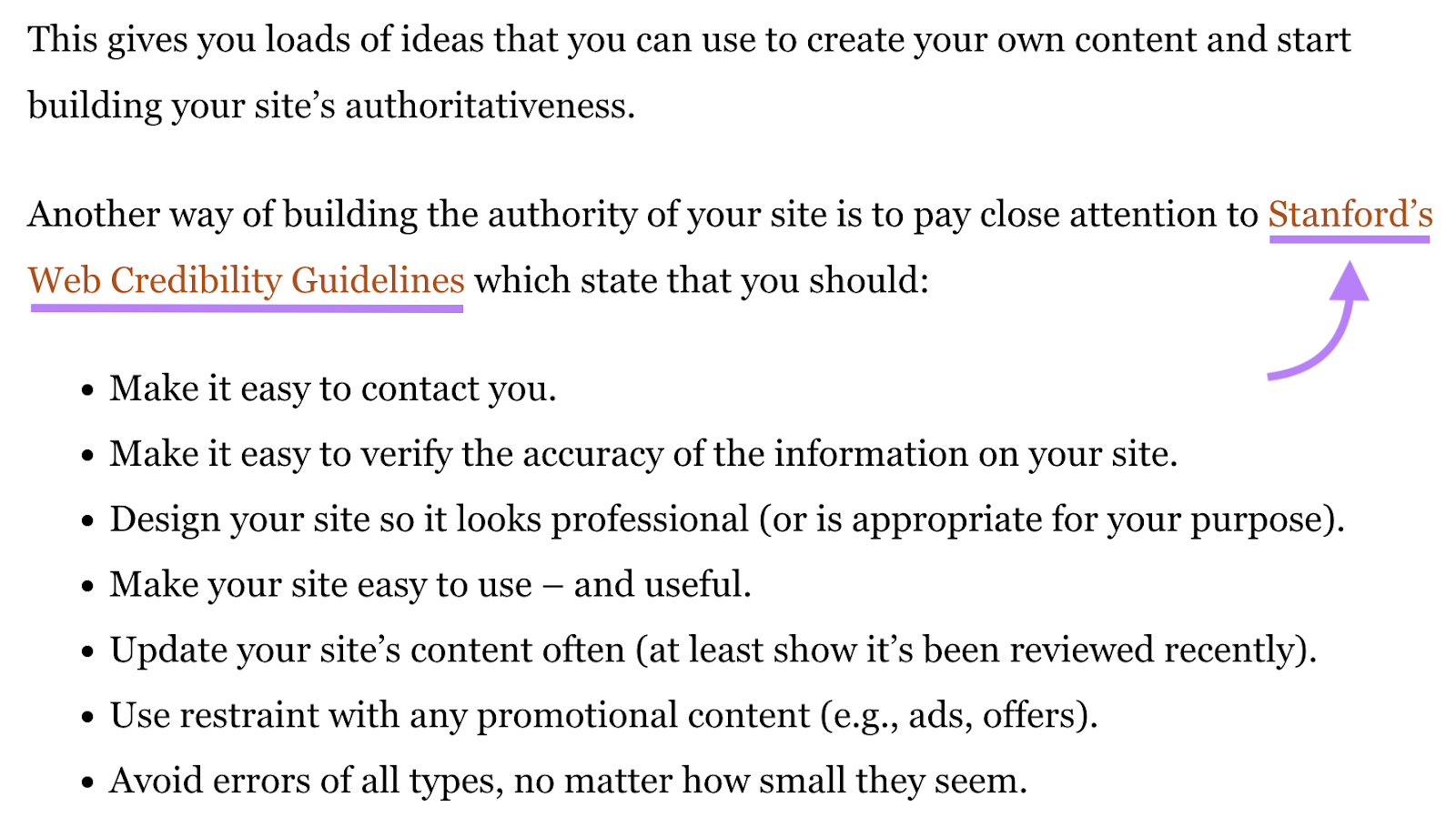
The article goes the extra mile—it includes quotes from Google, too. This gives readers valuable firsthand knowledge.
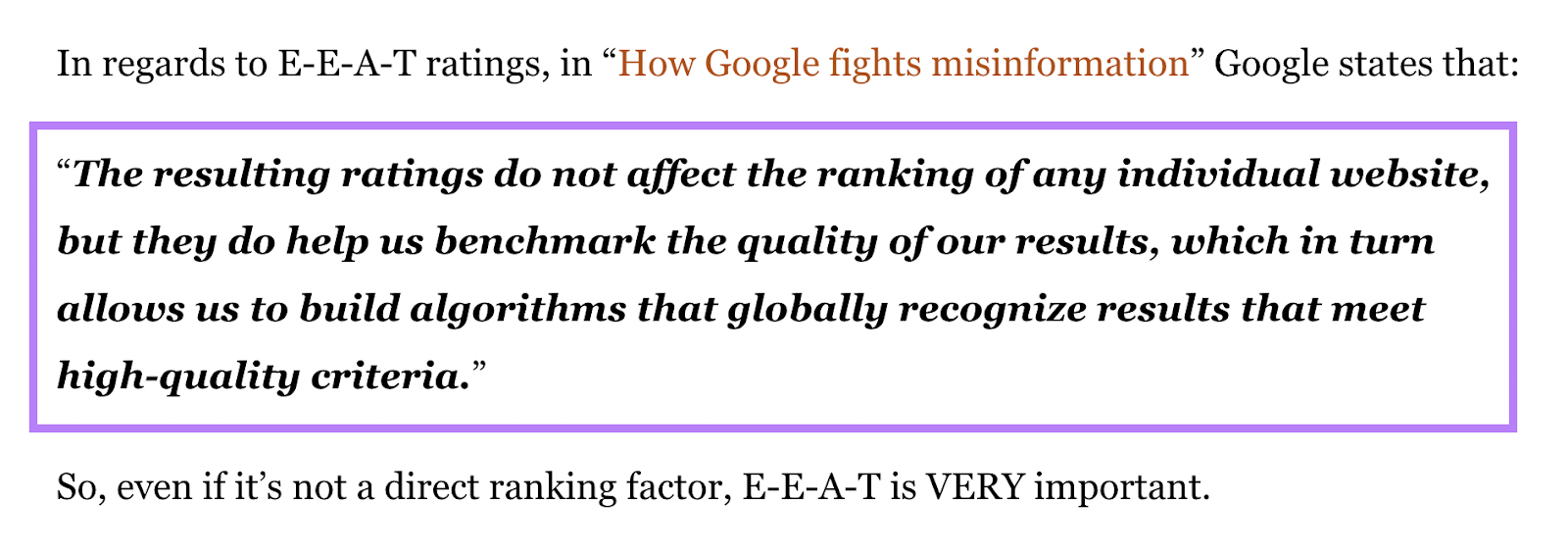
Implementing these tips in your article writing will help readers and search engines view your content as authoritative, accurate, and reliable.
4. Create an Outline
Creating an outline is an extra step. But it’s an important one.
Why?
Because it organizes your thoughts, dictates a cohesive flow, and ensures you don’t miss any crucial points.
Another benefit of outlining is that it makes the writing process more efficient.
You already have a clear plan, so you can focus on expanding on each point rather than wondering what to write next. This can save you a significant amount of time and effort.
Here’s how to create an article outline:
First, identify the key sections you want to include in your article. Under each main point, jot down the sub-points or details you want to cover.
It’s also a good idea to review the search intent behind the keywords you chose.
Search intent is the reason a user types a query into a search engine. Their search intent will influence the type of content they’re looking for.
There are four types of search intent:
- Navigational: When a user searches for a particular website or page
- Informational: When a user searches for information
- Commercial: When a user conducts research before making a purchase
- Transactional: When a user searches for a particular brand or product with intent to buy
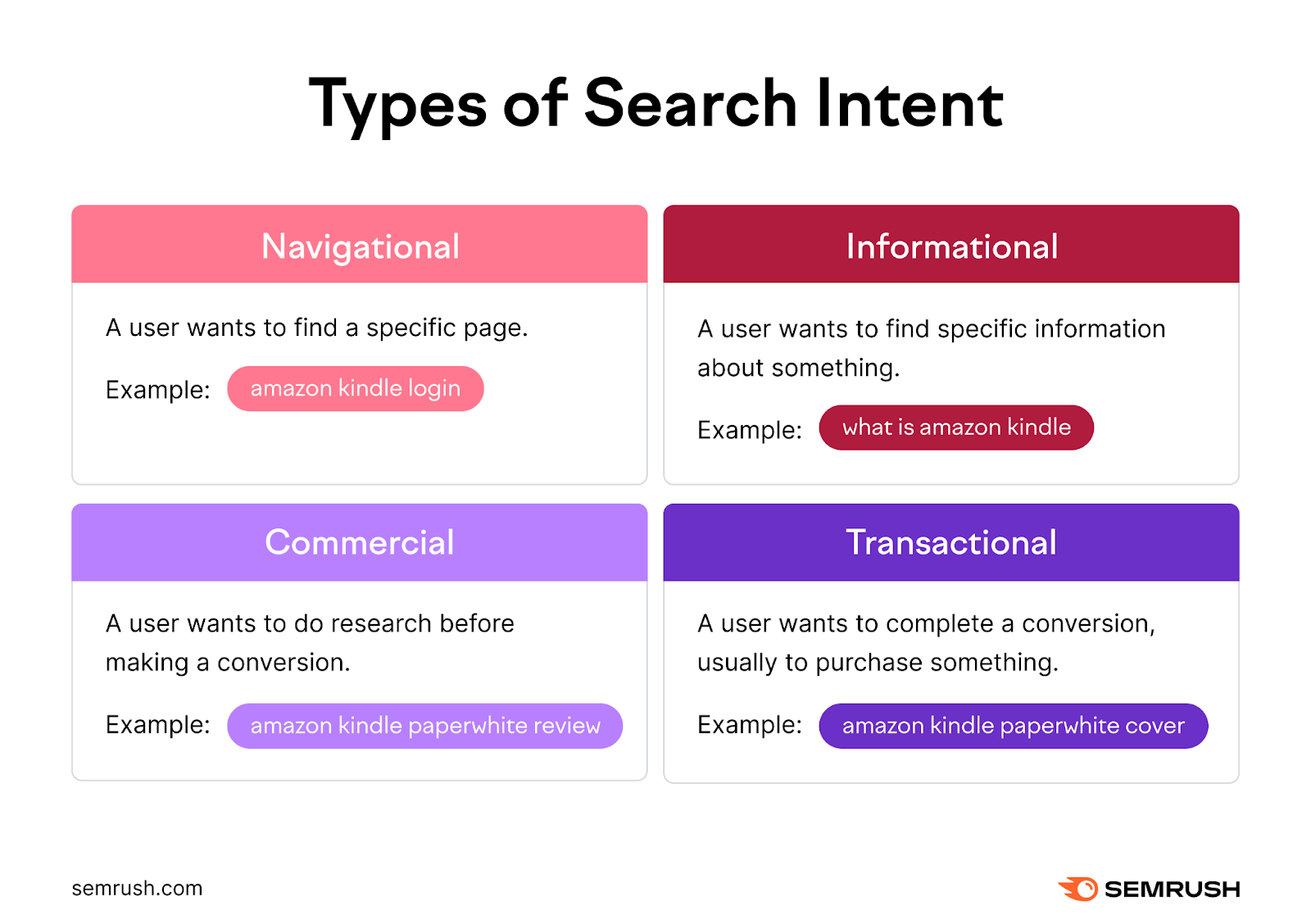
The keyword you choose—and the search intent behind it—will inform the type of content you create.
Why?
Because when someone searches and finds your content matches their intent, they’re more likely to stay on your site longer.
Plus, when Google’s algorithm recognizes your content is a perfect match for what a user searches for, your chances of ranking higher in the search results increase.
You can determine search intent in Keyword Overview.
Enter your keyword and click “Search.” Look for a box titled “Intent” in the “Overview” tab.
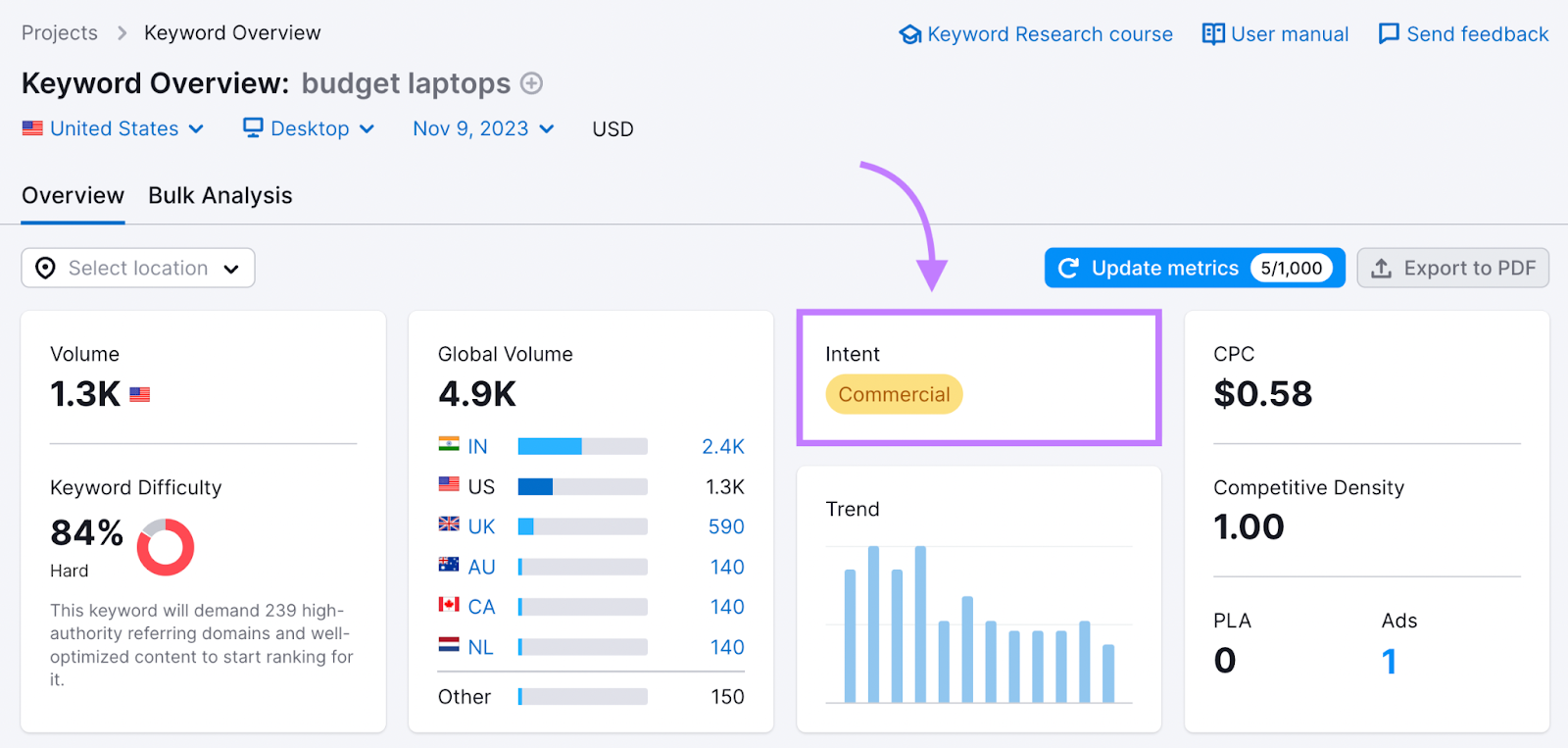
Here, we see the intent for “budget laptops.” The intent is labeled as “Commercial.”
In other words, when people search for “budget laptops,” they want to research options. They’re less likely to be searching for a how-to article or a news article with the latest industry insights.
So, you should construct your article outline to compare various budget laptops based on performance, price, and customer reviews.
This approach will help consumers make a well-informed decision when choosing a budget laptop that suits their needs.
For example, this article by PCMag ranks highly for “budget laptops” and has a clear outline that matches commercial search intent.
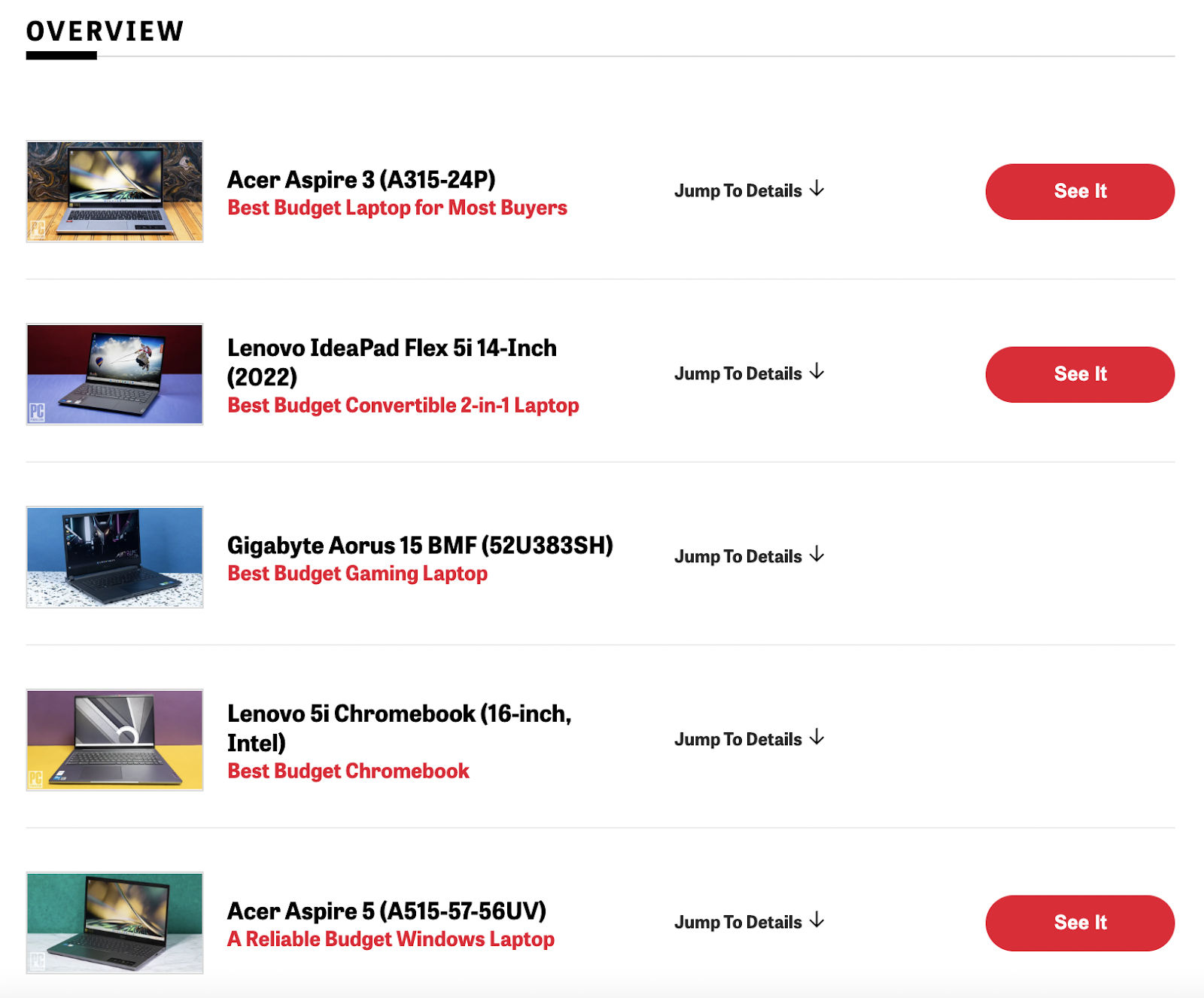
The start of the article provides a broad overview of the best budget laptops.
This aligns with the initial intent of users who search for general information about budget laptops. They want to see a list of options and get a sense of what’s available.
Then, it talks about each laptop in detail. This helps people who want more than just options—they want to know more to make a smart choice.
The article helps people conduct thorough research with explanations on why they picked each laptop, who it’s good for, and the pros and cons of each.
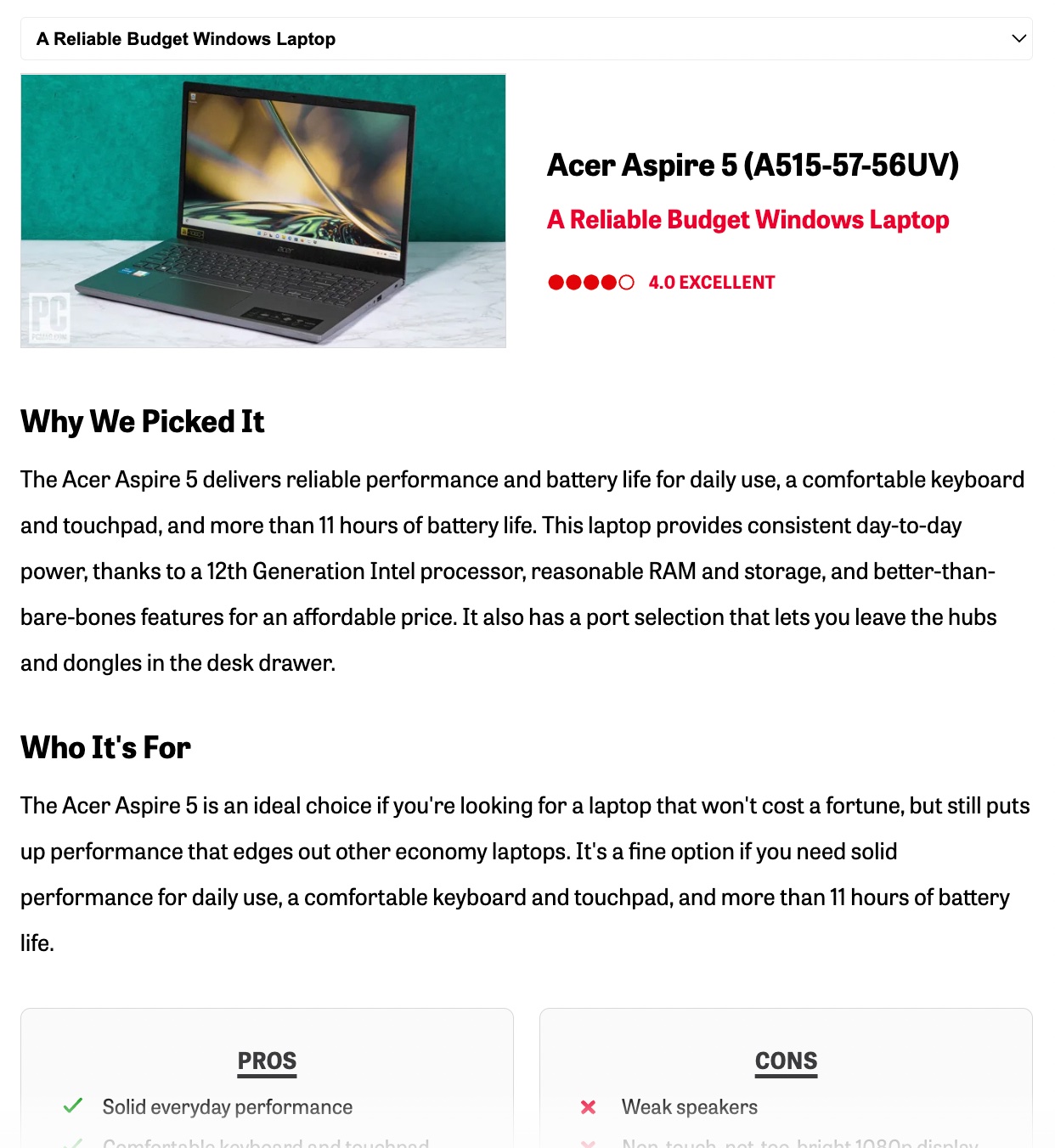
High-quality articles that satisfy search intent start with a strong outline.
To help you gather helpful information for your outline, use the SEO Content Template. With this tool, you’ll get SEO-friendly content recommendations, like keyword and length suggestions, to help guide your outline.
SEO Content Template also lets you automatically generate content briefs.
If you click “export to DOC,” you’ll have a content brief that you can then use to guide your own article writing or provide to writers and editors if you’re outsourcing content creation.
To get started, navigate to SEO Content Template and enter your keyword(s).
The template then gives you the recommended text length, readability score, semantically related keywords to include, potential backlink targets, and more.
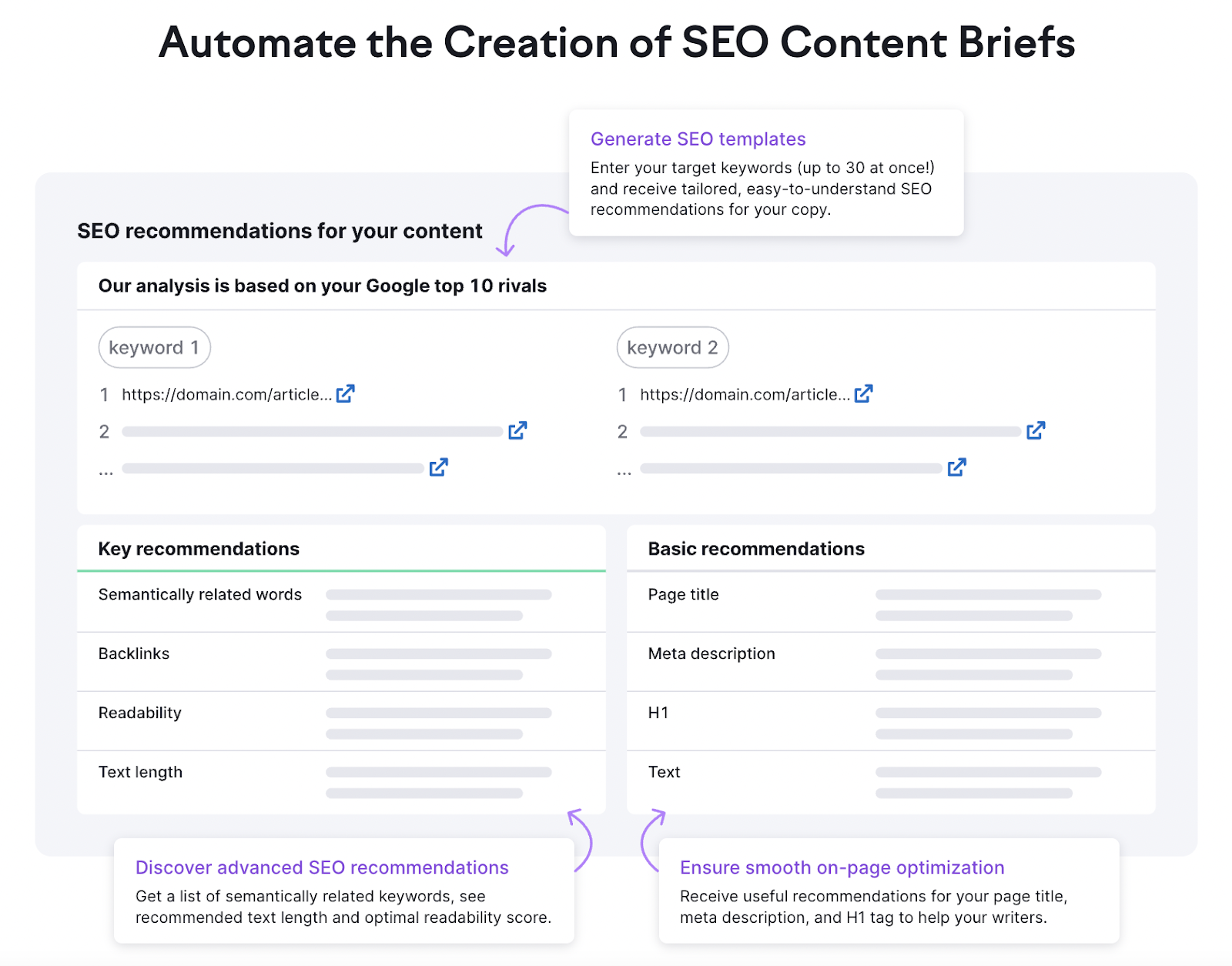
5. Write a Compelling Headline
Your article headline is the first thing people see. If it’s not intriguing, they might not click it.
Here’s what a headline looks like on the search engine results page:
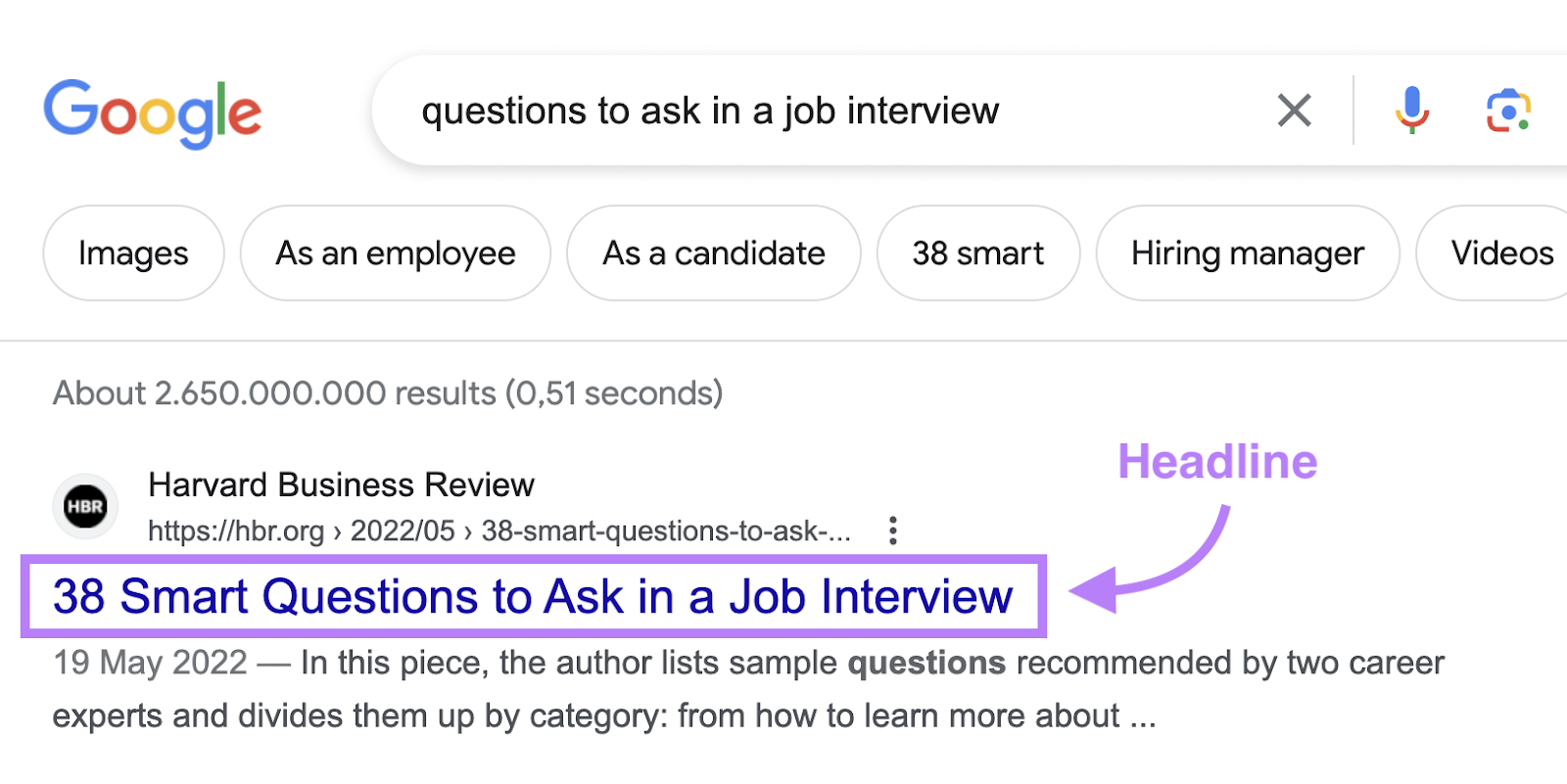
A good headline can significantly influence user behavior and drive traffic to the article. When your headline is compelling, you have a better chance of capturing the audience’s attention.
Here are some tactics for writing headlines that attract clicks:
Include the Target Keyword
Adding the target keyword in the headline tells search engines what your article is about, which can help improve your search engine ranking.
Plus, it informs readers that your article is relevant to their search query.
Here’s an example of a top-ranking article for the keyword “affiliate marketing”:
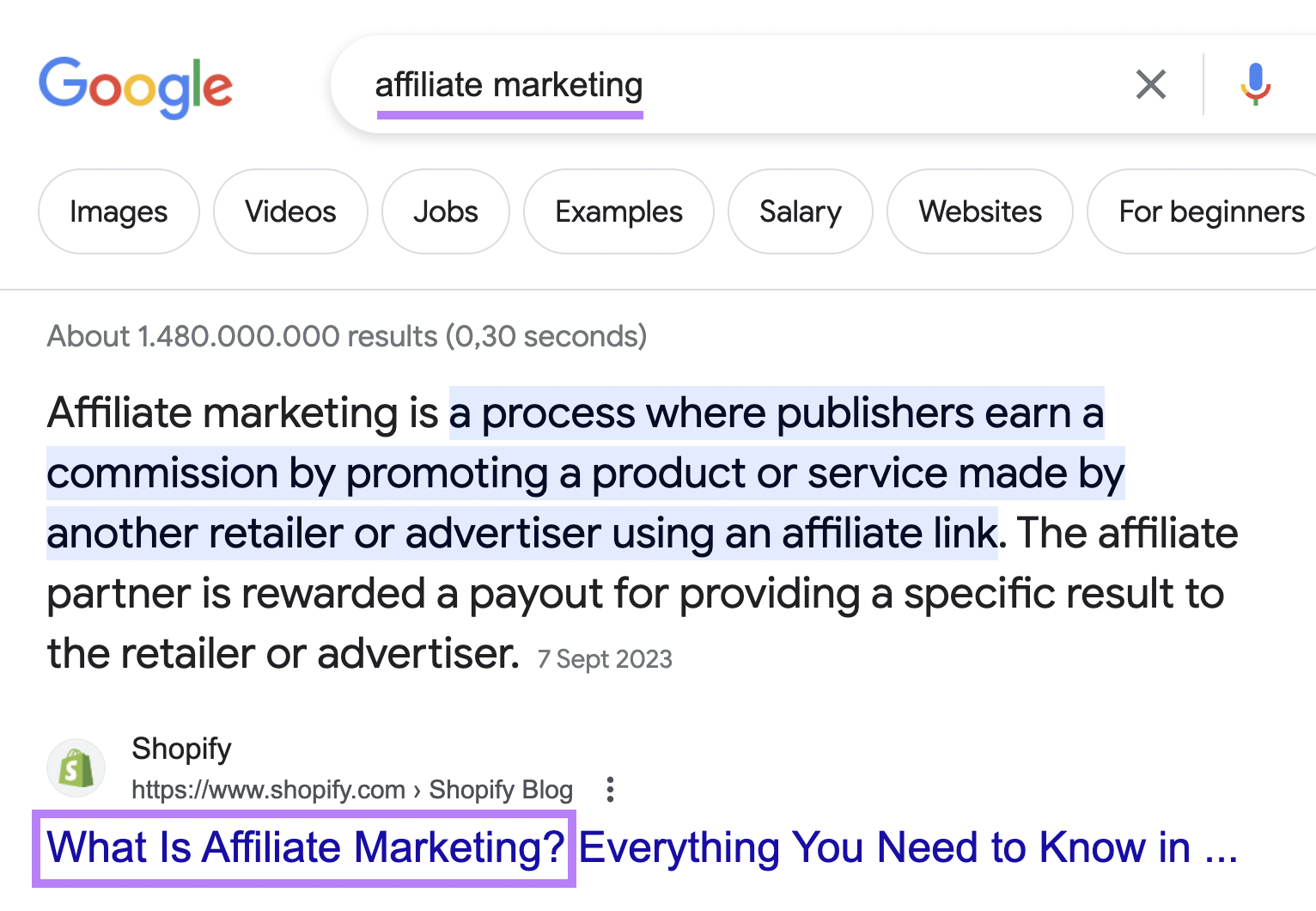
Notice how the target keyword (affiliate marketing) appears clearly in Shopify’s article headline.
Ensure the Headline Matches the Search Intent
Understanding search intent—which we discussed above—is crucial for writing effective headlines.
Your headline should align with the primary intent behind the keyword you target. This helps encourage clicks.
Let’s take the keyword “best video maker online” for example, which has a commercial search intent:
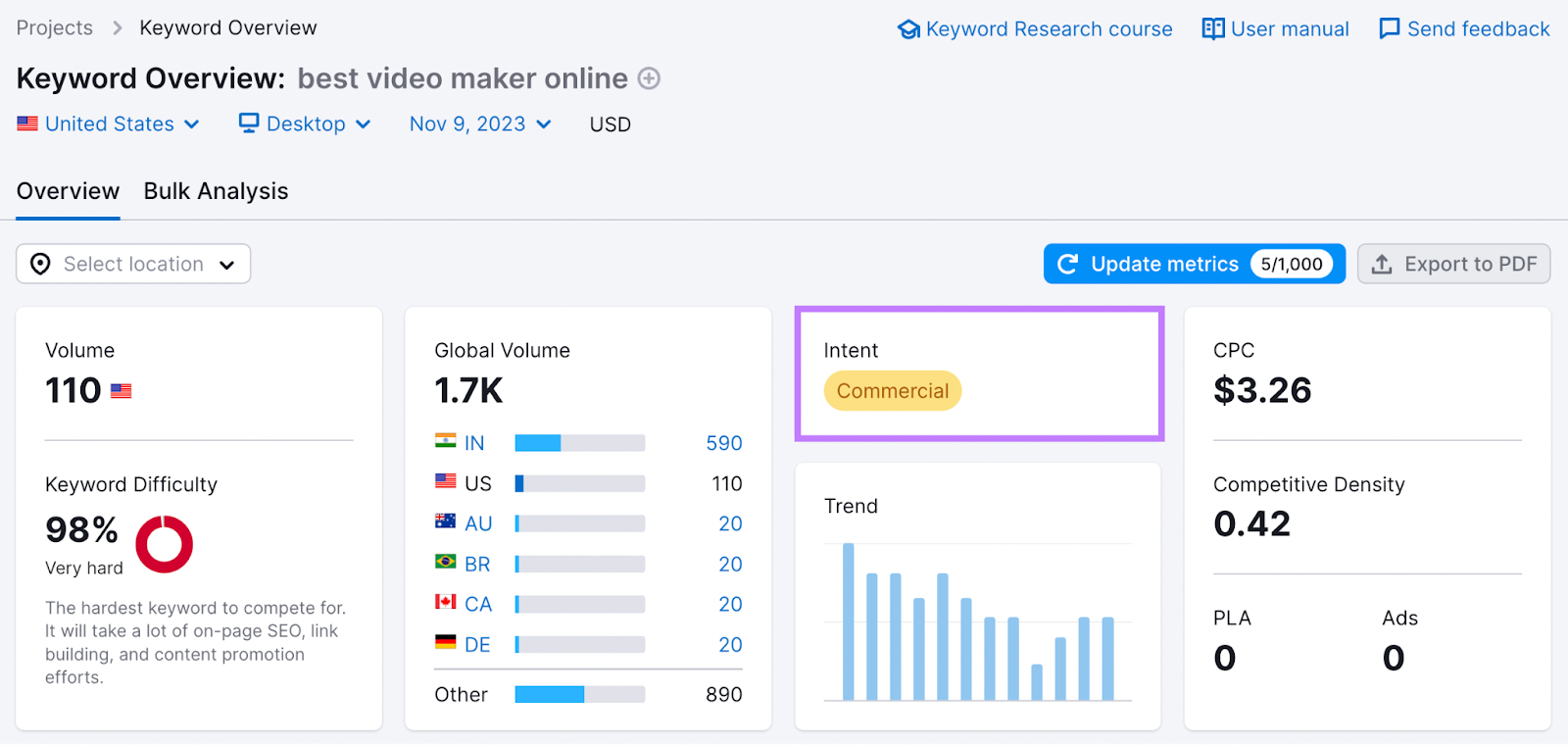
Commercial intent means anyone searching for this term likely wants to buy an online video maker.
The SERPs also reveal that when someone searches for the “best video maker online,” they want recommendations of online video maker tools.
Video editing company Wave.video’s article ranks highly for this keyword:

See how the headline perfectly matches the search intent? This is because the headline promises a curated list of online video makers.
Add Power Words and Numbers
Power words grab readers’ attention and evoke curiosity or urgency. They make readers feel an emotion––which is a powerful way to draw readers in and encourage them to click on your article.
Take this article headline, for instance:

The power word here is “boost.” It suggests improvement and growth, which can appeal to readers interested in advancing their careers.
Other power word examples include:
- Captivate
- ****
- Extraordinary
- Genius
- Challenge
You can also add numbers to article headlines for specificity and to clearly convey the article’s contents.
Here’s an example of an article headline that includes a number:

The number shows that the article offers a specific list of ideas, which can appeal to readers seeking internal communication ideas.
6. Draft a Strong Introduction
Learning how to create an article that hooks the reader starts with creating a strong, concise introduction.
The introduction is your chance to grab the reader’s attention, establish relevance, and communicate the value they’ll get from reading further.
Start your introduction with a powerful hook––something that piques your audience’s curiosity and encourages them to continue reading. This could be a relatable anecdote, shocking revelation, thought-provoking question, or bold assertion.
The key to a successful hook is relevance. Tie the hook to your article’s subject matter to set the stage for what’s to come.
Here’s an example of a good hook in technology company Drift’s article:

The opening line reads, “Inflation, talent shortages, supply constraints—manufacturers don’t have it easy in 2023.”
Here’s why this hook works:
This hook effectively draws readers in by addressing current challenges in a relatable way and hinting at the valuable information they can expect to find in the article.
Once you’ve got the reader’s attention with an engaging hook, offer a glimpse of what readers can expect to gain from your article. Provide a clear benefit or promise that encourages them to keep reading.
Here are two frameworks you can use for drafting the introduction:
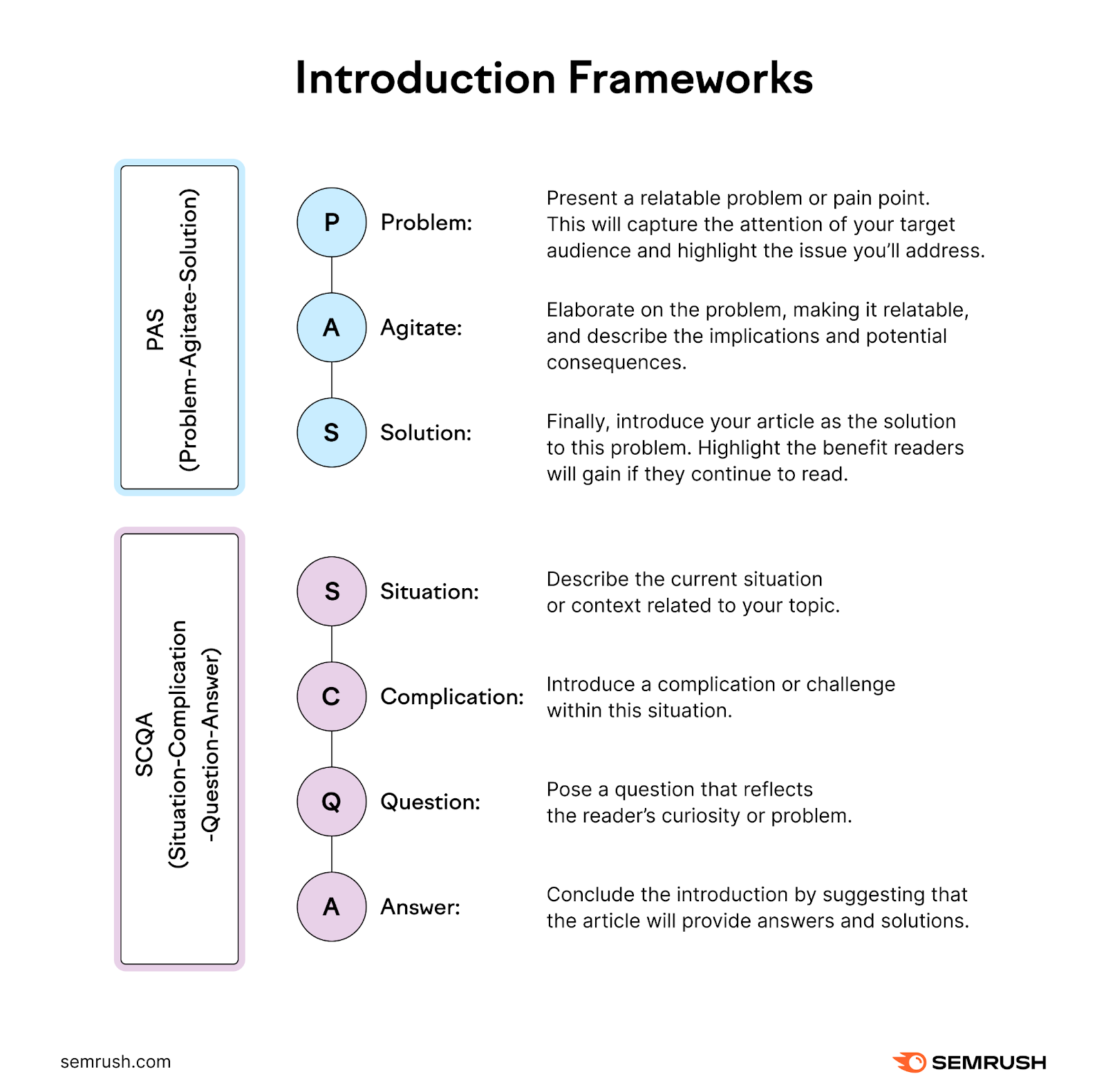
PAS (Problem-Agitate-Solution)
- Problem: Present a relatable problem or pain point. This will capture the attention of your target audience and highlight the issue you’ll address.
- Agitate: Elaborate on the problem, making it relatable and giving them a reason why they should solve it right away. Describe the implications and potential consequences.
- Solution: Finally, introduce your article as the solution to this problem. Highlight the benefit readers will gain if they continue to read.
SCQA (Situation-Complication-Question-Answer)
- Situation: Describe the current situation or context related to your topic
- Complication: Introduce a complication or challenge within this situation
- Question: Pose a question that reflects the reader’s curiosity or problem
- Answer: Conclude the introduction by suggesting that the article will provide answers and solutions
When You Should Skip the Intro
Introductions are an important part of articles. But there are situations where you can consider skipping them.
Let’s say you’re writing on a topic that demands a clear answer or definition. These are often “what is” queries.
If a reader is searching for a “what is” query, they’re looking for a fast, accurate answer.
In such cases, it’s better to give readers what they want right away without adding an introduction that obstructs the answer. This respects their time and gets to the point faster.
Here’s an example of a Semrush article where we jump straight into the core subject matter:
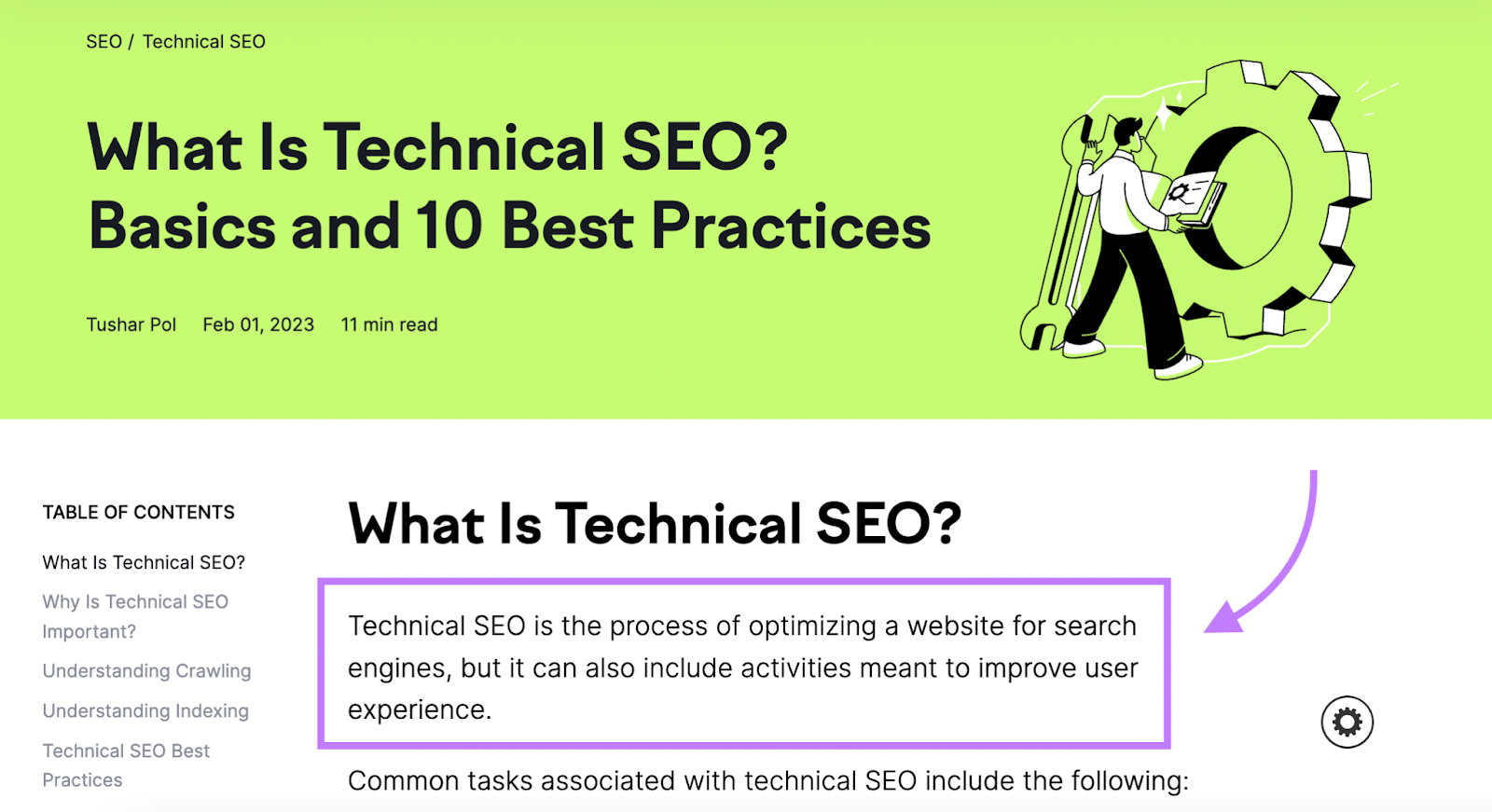
Since readers clicking on this article from search engines are looking for specific answers, we decided to skip the traditional introductory paragraph.
7. Use Descriptive Subheadings to Organize Content
Organizing your article with descriptive subheadings helps readers navigate content, find what they need, and stay engaged.
The Semrush State of Content Marketing: 2023 Global Report shows that high-performing articles have a variety of subheadings. This includes H2s and H3s, and if needed, H4s.
People read in different ways online. Some read every word, and some just want to find information quickly. Descriptive subheads can appeal to both.
Make sure your subheadings clearly convey what each section is about. This helps readers find the answers they need and encourages them to keep reading.
Remember: Using descriptive subheadings makes it easier for both people and search engines to understand your content.
If you have multiple levels of subheadings, use a standard heading hierarchy to visually organize your content.
Each level of heading represents a different level of importance, guides readers down the page, and improves the readability of your content.
Here’s how it works:
- Heading 1: The H1 tag is typically reserved for the main title of your article. It’s the most important heading. It should provide a clear overview of the content and contain the target keyword. In terms of hierarchy, it’s at the top. Usually, each page only has one H1 tag.
- Heading 2: H2 headings divide your content into main sections or topics. These headings give readers an idea of the major points you’ll cover. Use these as the skeleton for the outline and to convey search intent. They’re the next level down in the hierarchy.
- Heading 3: H3 headings are subheadings that break down the main sections into smaller subsections. They provide more specific information to back up the H2 heading and create a logical flow.
You can further subdivide content using H4, H5, and H6 tags, although these are less commonly used.
8. Summarize Key Points and Include a CTA in the Conclusion
The conclusion is where you tie everything together and emphasize the main takeaways from your article. This way, you reinforce your message and make sure your readers remember the most important information.
Consider including a call to action (CTA) in the conclusion, as it guides people on what to do next.
Whether it’s subscribing to your newsletter, exploring related articles, or taking a specific action, an actionable CTA can boost engagement and further your content marketing goals.
Some CTA examples:
- Subscribe now
- Read more
- Buy now
At the end of your article, either before the conclusion, after it, or even in place of it, you may choose to have an FAQs section. While FAQs aren’t needed for every article or blog post, they can add depth and value to some topics.
Your FAQ section should have its own subheading (an H2 or H3, depending on your preference) of “FAQs” or “Frequently Asked Questions.”
Then, briefly touch upon two or three of these common questions as FAQs and provide concise answers or insights. This shows that you understand your readers’ concerns and are eager to help.
For instance, here’s the “People also ask” section that shows up when searching “real estate social media content” on Google:
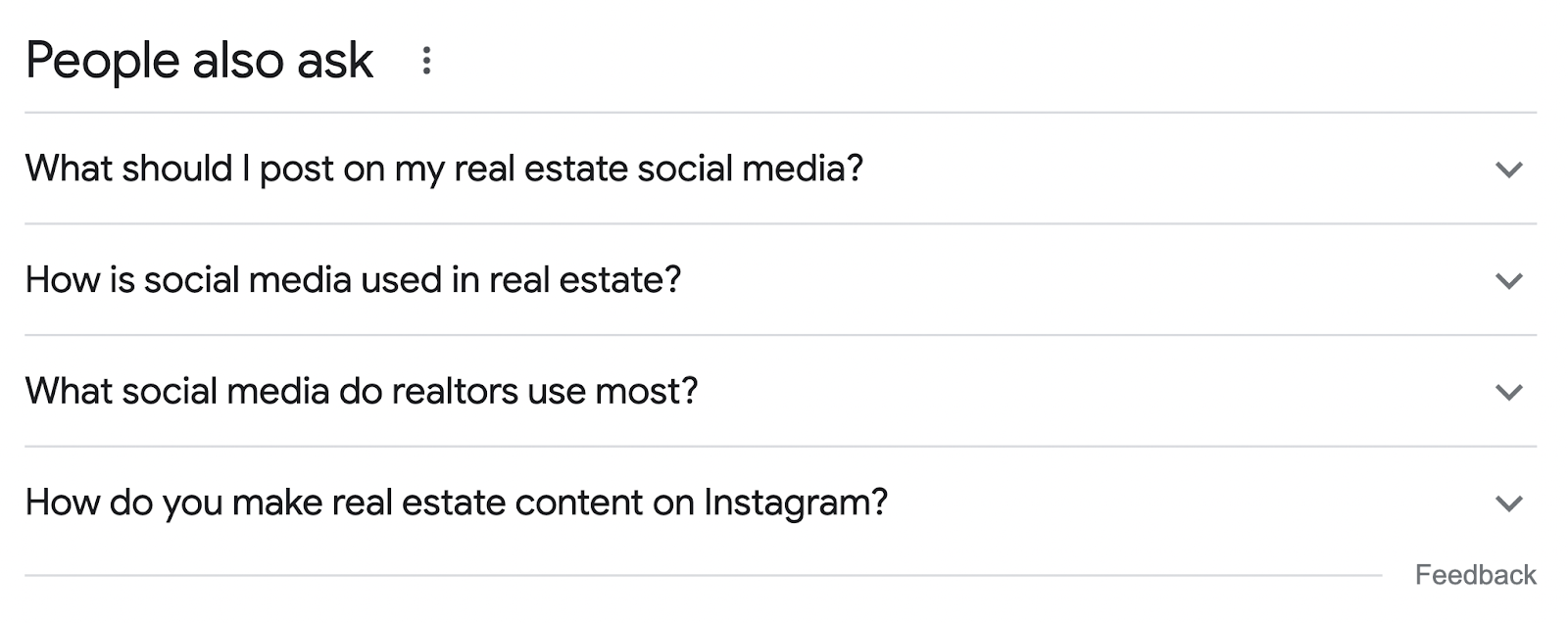
And here’s our article on social media for real estate. Notice how we addressed some of these questions in the FAQs:

9. Add Visuals
Learning how to write an article that keeps readers engaged means focusing on more than just the words you use—it means high-quality visuals, too.
Why?
Adding visuals to your article improves the reading experience and complements your written content.
You can use visuals, such as images, infographics, charts, screenshots, videos, and more, like we’ve done throughout this article.
Visuals simplify complex ideas or data, making them easier for your audience to understand. For example, a well-placed chart or table can explain a concept more effectively than paragraphs of text.
They also make your article more visually appealing as they can break up blocks of text. This lets you capture your readers’ attention, encourage them to stay on your page longer, and engage with your content.
Here are some tips for using visuals in articles:
- Choose relevant visuals: Select visuals that directly relate to your article’s content and support your key points. Ensure they contribute to the reader’s understanding or provide additional context.
- Avoid stock photos: Limit the use of generic stock photos. Use unique images and custom graphics that add value to the article. This not only boosts credibility but also makes your article more memorable to readers.
- Optimize: Compress images to reduce file size without compromising quality. Use appropriate image formats (JPEG for photographs, PNG for graphics), and consider using responsive design for mobile users. Tools like JPEGmini and TinyPNG can help with this.
- Provide captions and alt text: Include descriptive captions for images and use alt text to improve image SEO and accessibility.
Take a look at this Zapier article on customer acquisition strategy. It features a combination of visuals to clarify and emphasize 13 customer acquisition strategies:
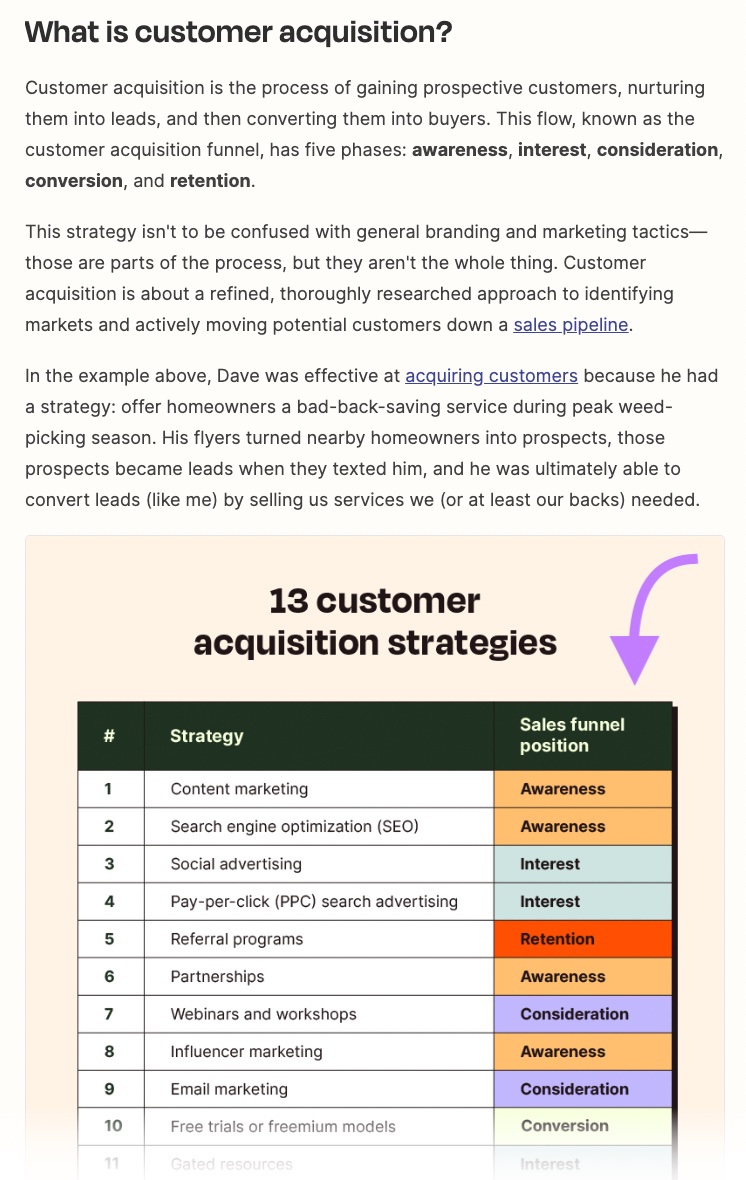
Zapier’s custom graphic provides a quick overview of customer acquisition strategies and where each one sits in the sales funnel.
They also included a screenshot of a Google search for leather couches to show how to make PPC ads stand out, which is one of the featured acquisition strategies.
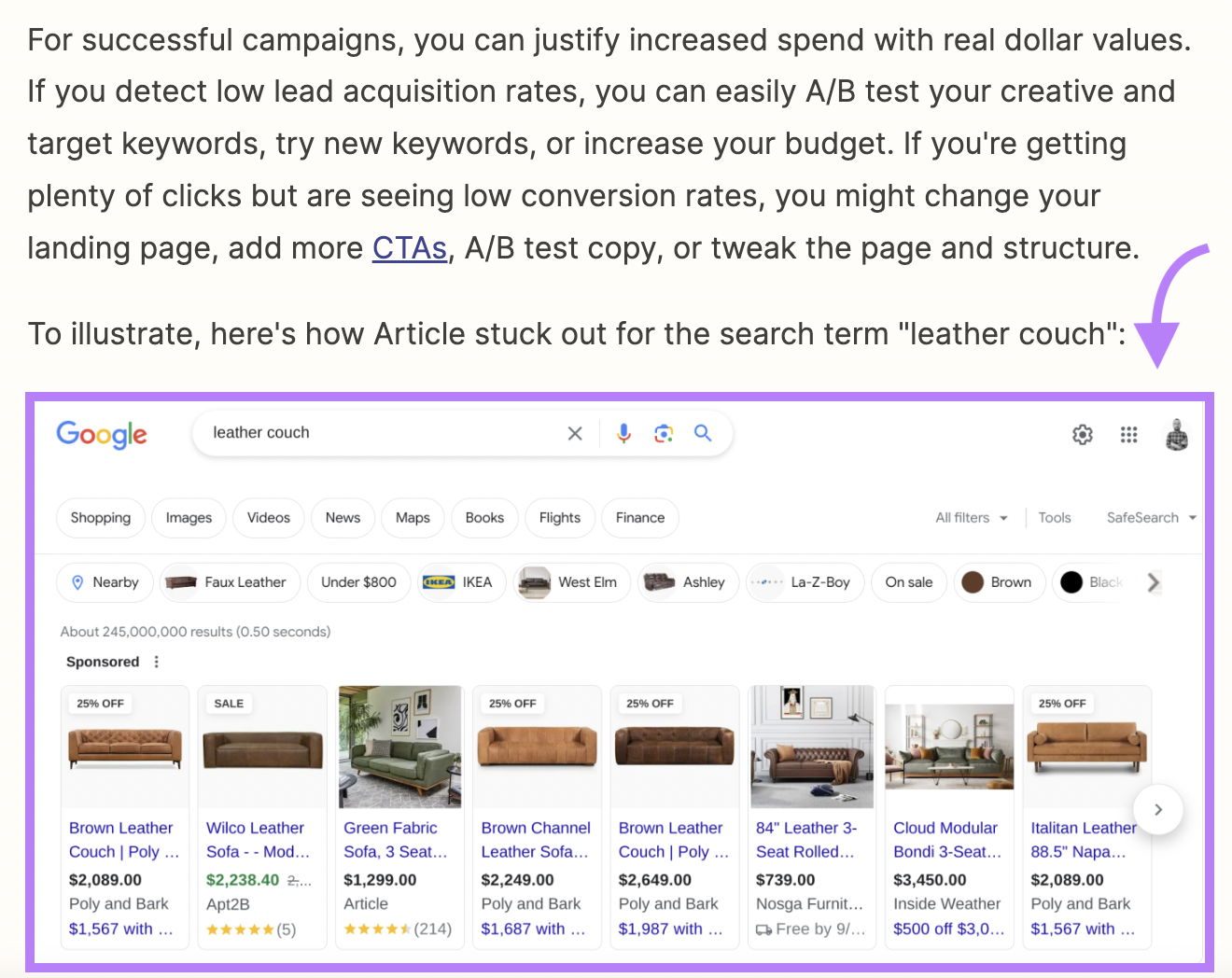
But they didn’t stop there. Zapier also included a TikTok video to demonstrate another acquisition strategy: influencer marketing:
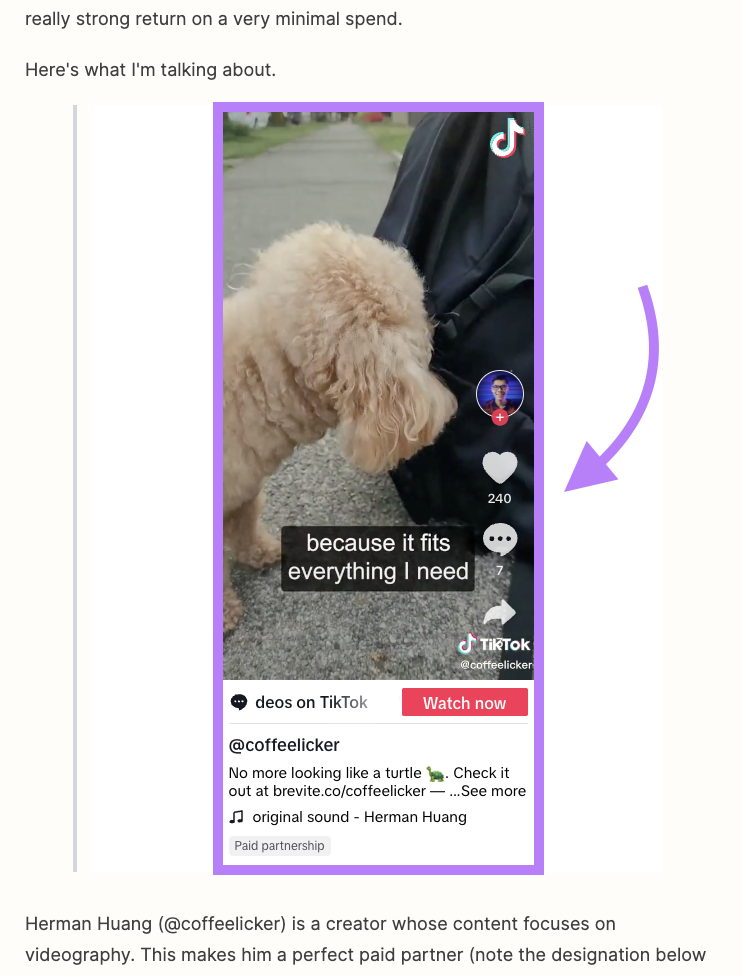
10. Edit and Proofread
Editing and proofreading ensure your content is polished and error-free. A well-edited article shows your commitment to quality content and builds trust with your readers.
After finishing your first draft, step away from it for a while. This break allows you to revisit your article with a fresh perspective.
Read your article aloud to catch awkward sentences, typos, and grammatical errors.
The key is to read your article as if you were a reader, not the author. Does it engage you? Is it clear and informative? Does it answer the questions you’d have as a reader?
These days, you don’t need to know your gerunds from your infinitives or be a whizz at English grammar to write a successful article. Use grammar and spell-check tools, like Grammarly and Hemingway Editor, to catch common errors.
If possible, get an editor to review the article before publishing. A fresh set of eyes can catch errors, readability issues, and offer valuable feedback.
5 Tips for Engaging Article Writing
Here are five tips to write better articles that stand out and engage your readers, from formatting to readability.
- Optimize for SEO: Use relevant keywords in your content, including them in your title, headings, and meta descriptions. This helps your article rank higher in search results, making it easier for people to find.
- Write short sentences and paragraphs: Short sentences and paragraphs are easier to digest, especially on smaller screens. Breaking down complex ideas into smaller, more manageable chunks ensures your content is accessible and engaging.
- Include examples: When you’re explaining something, show real-life instances or scenarios to help your readers understand better. It adds context and relatability to your content, making it more compelling.
- Make it easy to read and scan: According to HubSpot, 73% of users skim blog posts. Use subheadings, bullet points, bold formatting, and numbered lists to make your content scannable.
- Add CTAs to guide readers: CTAs guide your audience on next steps, keeping them engaged and involved with your content. This improves their overall experience and encourages them to take the desired action.
Article Writing Made Simple
Now that you know how to write an article that engages readers (and is optimized for search engines), consider how to speed up the process without sacrificing quality.
Using the right tools can make article writing easier and faster, helping you create valuable, relevant, and optimized content every time.
An efficient way to write great articles is to use Semrush’s SEO Writing Assistant. Import published text from the web or write new content directly in the tool to identify content issues, get readability suggestions, SEO recommendations, and more.
Source link : Semrush.com
